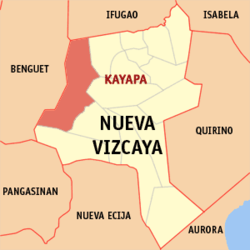Kayapa | |
|---|---|
| Municipality of Kayapa | |
 Municipal hall | |
| Nicknames: Gateway to the Cordilleras Summer Capital of Nueva Vizcaya | |
 Map of Nueva Vizcaya with Kayapa highlighted | |
Location within the Philippines | |
| Coordinates: 16°21′30″N120°53′10″E / 16.3583°N 120.8861°E | |
| Country | Philippines |
| Region | Cagayan Valley |
| Province | Nueva Vizcaya |
| District | Lone district |
| Barangays | 30 (see Barangays) |
| Government | |
| • Type | Sangguniang Bayan |
| • Mayor | Elizabeth Balasya |
| • Vice Mayor | Peter L. Bay-an |
| • Representative | Luisa L. Cuaresma |
| • Electorate | 16,376 voters (2025) |
| Area | |
• Total | 482.90 km2 (186.45 sq mi) |
| Elevation | 1,264 m (4,147 ft) |
| Highest elevation | 2,030 m (6,660 ft) |
| Lowest elevation | 628 m (2,060 ft) |
| Population (2024 census) [3] | |
• Total | 27,865 |
| • Density | 57.703/km2 (149.45/sq mi) |
| • Households | 6,130 |
| Economy | |
| • Income class | 3rd municipal income class |
| • Poverty incidence | 20.92 |
| • Revenue | ₱ 259.1 million (2022) |
| • Assets | ₱ 519.4 million (2022) |
| • Expenditure | ₱ 177.8 million (2022) |
| • Liabilities | ₱ 82.5 million (2022) |
| Service provider | |
| • Electricity | Nueva Vizcaya Electric Cooperative (NUVELCO) |
| Time zone | UTC+8 (PST) |
| ZIP code | 3708 |
| PSGC | |
| IDD : area code | +63 (0)78 |
| Native languages | Ilocano Gaddang Ibaloi I-Wak Kallahan Karaw Tagalog |
Kayapa, officially the Municipality of Kayapa (Gaddang : Ili na Kayapa; Ilocano : Ili ti Kayapa; Tagalog : Bayan ng Kayapa), is a municipality in the province of Nueva Vizcaya, Philippines. According to the 2024 census, it has a population of 27,865 people. [5]









